



Pre-Processing Handling in Broilers
There are a number of factors during pre-processing handling that can potentially influence carcass quality. Understanding these provides the basis for good management and welfare practices, optimal carcass quality, and flock profitability, according to Dr Rafael Monleon, Aviagen Veterinarian for the Asia Region.Summary
Feed withdrawal
Feed withdrawal (the removal of feed to empty
gastrointestinal tract [GIT] contents) reduces the risk of
faecal contamination at the processing plant. Feed should
be removed from the flock eight to 12 hours before the expected
time of processing. Water should be available continuously
until catching.
The feed withdrawal process must:
- be done in a balanced way, considering bird welfare at all times
- complement the normal eating pattern of the flock
- allow birds time to clean up all feed in the feeders, and
- allow the GIT to be emptied without excessive weight loss occurring.
Catching
During catching:
- minimise light intensity and avoid sudden increases in
light intensity
- control and adjust ventilation carefully to avoid heat
stress, and
- catch birds with care, avoiding injury.
Clear guidelines must be in place and the catching process
should be monitored and reviewed regularly. Appropriate
personnel training is essential.
Transport
Transportation should be done using suitable vehicles, which:
- provide adequate protection from the weather and appropriate ventilation, and
- are within the local current guidelines or legislation.
During transportation:
- use ventilation, extra heating and/or cooling when necessary
- minimise stops, transport distances and transport time, and
- adhere to local current guidelines or legislation.
Holding
Upon arrival at the processing plant, birds need to be held
in a cool, weather-proofed area. Humidity, temperature
and bird comfort should be routinely monitored, and
holding time prior to slaughter minimised.
Conclusion
Correct pre-processing handling results in a successful
transition from farm to processing plant: maximising bird
welfare, carcass quality, and flock profitability.
Introduction
Pre-processing handling, the management of birds during the last 24 hours prior to slaughter, is a vital step in preparing for broiler meat processing. In this final stage of the broiler management cycle, the procedures put in place (feed withdrawal, catching, transportation, and holding) can substantially influence bird welfare, carcass yield and grade, and overall profitability.
Feed Withdrawal
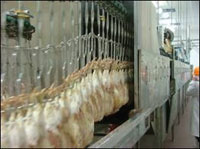
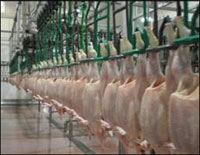
The purpose of feed withdrawal is to allow the contents
of the gastrointestinal tract (GIT) to be emptied prior to
processing. This reduces the risk of faecal contamination
at the processing plant (Figure 1), resulting in better
profitability, product safety and shelf-life. It also reduces
the labor costs associated with re-processing carcasses to
remove or clean contamination.
Feed withdrawal plans should be monitored and reviewed
constantly and must be modified promptly if problems occur,
but as a general rule of thumb, feed should be removed
from the flock eight to 12 hours before the expected processing
time.
| Feed Withdrawal Period |
|---|
Time in the house without feed + Catching time + Transport time + Time in the holding (lairage) area prior to processing |
The feed withdrawal process must complement the normal
flock eating pattern, and consider bird welfare at all times.
Prior to catching, birds must have sufficient time to clean
up feed in the feeders, and to empty the contents of the
GIT without incurring excessive pre-processing body weight
loss. Routine monitoring of birds on the farm (for preprocessing
weight loss), and at the processing plant (for
pre-processing weight loss and crop fill, or any signs of faecal
contamination) will ensure the feed withdrawal program is
working effectively.
The rate at which the contents of the GIT are cleared can
be affected by:
- Darkness. The rate of GIT clearing is reduced in the
dark. To achieve good GIT clearing, birds should receive
light for at least four hours after feed has been withdrawn.
- Placement of birds in transport modules. The rate
of GIT clearing decreases once birds have been placed
in transport modules. Avoid placing birds in transport
modules within four hours of feed being withdrawn.
- Temperature.
- Hot temperatures decrease feed intake but increase water consumption, affecting the consistency of faecal material, and increasing the rate of GIT clearing. During hot weather, the feed withdrawal period may need to be shorter.
- The rate of GIT clearing and the frequency of eating is decreased at cold temperatures (below 16°C, 60°F). In cold weather, the feed withdrawal period may need to be longer.
Water must be available continuously until the point of
catching. Without water, birds may become dehydrated and
the GIT will not be emptied. However, if prior to catching,
birds are without feed for more than five hours, water
consumption will be increased, thus increasing the water
content of the GIT and the risk of carcass contamination at
the processing plant.
During feed withdrawal, leaving the feeders down until the
catching crews arrive may help to reduce litter eating. Once
feed has been depleted, birds will then peck at the feeders
rather than the litter.
After feed withdrawal has started, it is important to avoid
disturbing the flock (e.g. excessive walking of the house or
opening of doors).
Feeding patterns and feed withdrawal
A flock of birds will normally develop a well-defined pattern
of feed consumption. Broilers in a comfortable environment,
with constant access to feed and water, will eat and drink
at a steady rate throughout the day - eating approximately
every four hours and drinking several times during that four-hour
feeding cycle. Feed consumption patterns should not be
altered in the last few days, and more importantly, during
the last 24 hours prior to transportation. If normal feeding
patterns become disrupted, aggressive and uncontrolled
eating may develop, particularly if birds are without feed for
a prolonged period of time. Uncontrolled eating results in an
unpredictable clearing of the GIT that will increase the risk
of faecal contamination during processing.
Feeding patterns are affected by a number of factors and
these factors must be taken into account when considering
appropriate feed withdrawal periods.
- Feed availability. If feed amount and feeding space
are not adequate, competition increases for feed and
feeding space which will affect feeding patterns.
- Light. Birds adapt feeding patterns to the lighting
program they are on. Birds stop eating in the dark.
If a lighting program is used, and dark periods are
excessive, birds will eat larger quantities of feed when
it becomes available (compensatory eating). The longer
the lights are off, the more severe compensatory eating
will be. As all birds will want to eat at the same time
when the lights come on, normal feeding patterns may
be further disrupted due to over-crowding at the feeders.
Provision of adequate feeding and drinking space is
critical when lighting programs are implemented.
- Temperature. High environmental temperatures reduce feed intake, while low environmental temperatures may result in uncontrolled eating.
Assessing the crop fill of 20 to 30 birds prior to shackling is a useful means of determining whether or not alterations in feeding pattern have occurred. If, at shackling, more than 10 per cent of the sample is found to have full crops or large quantities of feed in the crop, it is likely that feeding patterns have been disrupted, and that feed withdrawal has been inappropriate. Investigations into the reasons for this should take place.
Pre-processing weight loss
Some weight loss will occur during feed withdrawal due
to removal of GIT contents. However, once the GIT is
completely empty of feed, the rate of weight loss increases
as body reserves of fat and protein (muscle) are mobilized
to support metabolism (a process known as pre-processing
weight loss or ‘live-shrink”). Excessive feed withdrawal
time can have a negative impact on carcass yield, carcass
quality, and profitability. Feed withdrawal must provide a
balance between achieving good food safety and avoiding
excessive weight loss.
Once the GIT is completely empty, pre-processing weight
loss figures typically range from 0.1 to 0.5 per cent loss in body
weight per hour. The exact amount of weight loss that
occurs will vary depending on:
- Bird age. Weight loss will be higher in older birds.
- Sex. Weight loss will be higher in males.
- House temperature. Weight loss will be increased in extremes of temperature (both high and low).
- Eating patterns before feed withdrawal. If eating patterns are altered or interrupted prior to feed withdrawal variability in GIT contents among birds will be increased.
- Length of time in transport modules. The more time spent in transport modules, the higher the weight loss will be.
- Holding temperature. Higher holding temperatures lead to increased weight loss.
| Example |
|---|
| Effects of pre-processing weight loss on profitability.
Assumptions: Processing age = 42 days Body weight = 2768g Number of birds processed per week = 1 million Meat value = $1.00/kg live weight With no pre-processing weight loss each bird would be valued at $2.77. If birds were left for only 1 hour without any feed after the GIT has been completely emptied, each bird would be estimated to lose 0.3 per cent (or 8g) of its live weight and would therefore weigh 2760g. Each bird has a reduced valued at $2.76. A total loss of $10,000/week. |
A simple and effective method for calculating pre-processing weight loss is to mark and weigh a sample of 20 to 30 birds at each stage of the pre-processing handling procedure (following the same birds all the way through):
- Preparation (including feed withdrawal) to catching. Weigh birds about four hours prior to catching.
- Catching to transport. Weigh birds just before the truck leaves the farm.
- Transport to holding. Weigh birds on arrival at the processing plant.
- Holding to processing. Weigh birds just prior to shackling.
If weight loss is higher than expected at any point in the process (based on historical records), the reasons for this should be investigated, and the feed withdrawal programme appropriately modified.
Catching
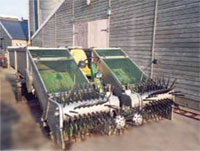
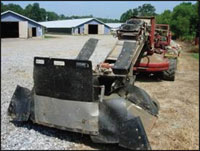
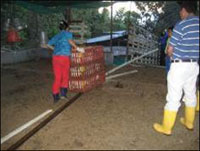
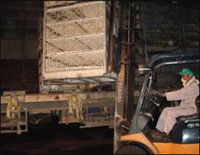
Bird stress during catching should be minimized. Light
intensity should be reduced to a minimum, and any sudden
increases in light intensity avoided. When catching is
conducted during daylight hours, the use of curtains over
the main doors will help to minimise light intensity in the
house and reduce stress.
Ventilation must be controlled and adjusted carefully during
catching to avoid heat stress, and birds should be monitored
closely for any signs of over-heating (panting).
Catching can be completed manually or mechanically.
With mechanical catching (Figure 2) 4,000 to 5,000 birds
an hour can typically be caught. The potential benefits of
mechanical catching (when properly managed according
to manufacturer recommendations and with appropriate
training) are:
- Improved bird welfare through decreased catching stress and injury rates
- Lower operating costs, and
- Improved working conditions.
However, the initial set-up costs of mechanical catching
are high, and it is not suitable for use in all operations.
Mechanical catching is best suited to modern facilities
where houses tend to be wider and are clear span (free
from internal structural obstructions).
Methods of manual catching vary from country to country
depending on equipment and labor availability. Manual
catching crews typically catch and crate between 7,000 to
10,000 birds an hour. However, personnel can be subject
to fatigue and may perform inconsistently during a shift.
The use of forklift trucks to bring transport modules into the
house, or PVC pipes to aid movement of transport modules
through the house (Figure 3), can make manual catching
easier.
Catching crews must be properly trained in bird handling
and welfare. Birds should be caught carefully, and held by
both shanks, or by the breast with both hands to minimize
distress, damage and injury, e.g. bruising or hip and wing
dislocations. Clear guidelines on bird handling must be in
place and the catching process should be monitored and
reviewed regularly.
The most common lesion associated with mishandling during
catching is bruising. Around 90 to 95 per cent of the bruises found on
broilers at processing occur during the last 12 hours prior to
slaughter. Of these, typically 35 per cent are caused by the grower,
40 per cent occur during catching, and the remainder occur during
transport, unloading and shackling.
Analyzing the colour of any bruises seen in the processing
plant to determine their age (see Table 1), and therefore at
what point in the process they occurred, is a useful means
of establishing where problems exist, and if any additional
training is required.
| Table 1. Changes in bruise colour with time. | |
|---|---|
| Time | Colour |
| Minutes | Red |
| 12 hour | Dark red - purple |
| 24 hour | Light green - purple |
| 36 hour | Yellow, green - purple |
| 48 hour | Orange |
| 72 hour | Yellow - orange |
| 96 hour | Slight yellow |
| 120 hour | Normal color |
| Based on original work by Hamdy et al., 1961 | |
Having a member of staff from the processing plant
monitoring the catching process may also be a worthwhile
exercise.
Bruises are occasionally attributed to mycotoxins, e.g. aflatoxin. However, aflatoxin only increases the
susceptibility to bruising, it does not cause it. Bruising only
occurs as a result of some sort of trauma/mishandling.
Transport modules should not be overfilled, and local
legislation must be adhered to. If the number of birds per
module is too high, over-heating, increased bird stress,
mortality, and a higher incidence of condemnations at
the processing plant may occur. The number of birds per
transport module must be reduced in high temperatures. The exact level of reduction is difficult to quantify and
will depend on the temperature, the size of the transport
module and local legislation policy.
Transport
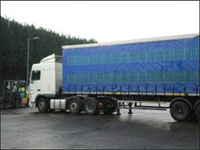
Transportation vehicles (Figure 4) must provide adequate
protection from the weather, appropriate ventilation, and
comply with local current legislation.
The micro-climate inside the bird compartment of the truck
will be different to the temperature and humidity outside,
and could be detrimental to the birds. This is especially true
when the vehicle is stationary. Ventilation and extra heating
and/or cooling should be used when necessary. Stops
during transportation should be minimized.
preferred and the use of fans to keep air circulating through
the modules should be considered. Allowing at least 10cm (4") between every two tiers of transport modules, or
introducing empty transport modules at regular intervals
throughout the load, will improve air-flow and can reduce
heat stress.
In cold weather, the load should be covered to minimize
chill, and bird comfort should be checked.
Long transport times can increase the number of birds
being dead on arrival (DOA) at the processing plant. When
transporting birds, seek to minimize transport distances and
operate within local legislation guidelines. The transport
route must be planned in advance, and the transportation
schedule adhered to.
Holding
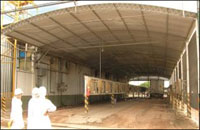
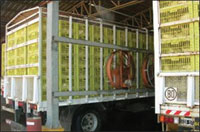
Upon arrival at the processing plant, birds need to be
held in a cool, weather-proofed area (Figure 5). Humidity,
temperature, and bird comfort should be monitored on a
routine basis. If birds are observed huddling (cold distress)
or panting (heat stress), then environmental conditions are
not optimal and should be altered immediately.
Fans can be used to help keep the birds cool and well
ventilated in the holding area (Figure 6). Fans should be
carefully positioned to ensure a good, even air flow through
the crates. Appropriate spacing between the trucks, or
inserting empty modules into the bird compartment of the
truck, will help improve air-flow around the birds.
During periods of high temperature, foggers can be used
to help keep birds cool. Foggers must be well-maintained,
and should not be used when relative humidity is greater
than 70 per cent because the capacity of birds to lose heat will be
compromised. If foggers are used, it is important to make
sure birds are dry when placed on the processing line. If
birds are wet, the effectiveness of the electrical bath stunner
may be reduced - compromising bird welfare and carcass
quality.
During periods of cold weather, it may be necessary
to provide extra heating in the holding area. Adequate
ventilation must be maintained at all times.
Holding times at the processing plant should be minimized
and birds processed as quickly as possible. Excessive
holding periods compromises carcass quality and more
importantly, bird welfare.
Conclusion
Pre-processing bird management can have a significant impact on bird welfare, food safety, and profitability. It is important to achieve a clear understanding of how to manage birds during the 24 hours prior to processing through:
- Applying good feed withdrawal practices to prevent faecal
contamination at the processing plant and minimize the
effects of pre-processing weight loss.
- Catching should be done with care to avoid injury and
also quickly and efficiently, to minimize the time taken to
transport the birds to the processing plant.
- Transport vehicles must provide birds with the
appropriate protection and ventilation to minimize
stress.
- Holding time at the processing plant should be kept to a minimum and proper environmental control in the holding area is critical.
All stages of pre-processing management should be
monitored and reviewed regularly to ensure it remains
efficient while maintaining bird welfare.
Following the guidelines described in this article can help
achieve a successful transition from farm to processing
plant, maximising bird welfare, carcass quality and flock
profitability.
November 2012








